As he was listening, he felt fear was growing. It was alien to his daily experience, but he was almost suddenly popularized. In the ten years of his life he had impressions of countless worlds carved in the brain, but no one who has heard that sound can ever forget it. He was listening to the voice of the wind, which was whispering and whistling above himself in a lifeless landscape a hundred meters away.” 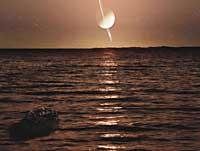 G. Kervina / NASA Duncan Makenzie is a titanic that is the chronicle of an experience lived in childhood, in this environment of 2276. That is, Arthur C. Imaginary of Clarke*. We do not know if within two hundred and fifty years the human being will have the capacity to colonize Titan, nor if humanity will endure on Earth, but if we were there we could hear the noise and sighs of the wind, alafede, the only atmospheric satellite of the Titan Solar System. Both wind and noise need atmosphere to exist, pure physics, nothing else. If reality is tangible, at least since last July, the Cassini-Huygens spacecraft is orbiting the Saturn system and we hope that with Christmas Day Huygens will leave the Cassini company to undertake the exploration of Titan. We face a great technological challenge, due to the difficulties of the mission, but to science as a prelude to a huge contribution. What does Titan have to attract the interest of scientists and for NASA and ESA to spend 32 billion euros? Saturn's largest satellite It was first discovered by Dutch astronomer Christian Huygens on 25 March 1655 and was the first satellite discovered after Jupiter satellites discovered by Galileo. 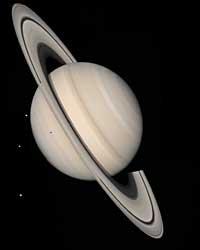 Saturn and its three moons, Tetis, Dione and Rea, from closer to farther. ANDÉN For a long time it had no name and was called the sixth satellite of Saturn, until in 1847 the astronomer John Herschel proposed to designate the 7 satellites of Saturn that were then known. The sixth was played by Titan and the rest by order of distance: Mima, Entzelade, Tetis, Dione, Rea and the seventh Japeto. Why Huygens chose the names of titans, giants and oceanists to designate Saturn's satellites, but it seems a nice excuse to delve into Greek mythology. Titan is the largest of Saturn's satellites and for years has been in full competition with Jupiter's Ganimide to grab the txapela of the solar system's largest satellite, but finger measurements have sent to second place. However, it is greater than Mercury, although its mass is smaller and therefore greater than Pluto. Greatness is not the main thing of Titan, but to be the only satellite of the solar system with atmosphere. As on our planet, the atmosphere is mostly composed of nitrogen, specifically 94%. In addition, it contains methane and other hydrocarbons (ethane, methylacetylene, acetylene, propane, etc.) and other nitrogen and carbon compounds (carbon dioxide, hydrogen cyanide, cyanogen and nitriles). The complex chemistry of these organic compounds originates from methane decomposed by sunlight. Titan has no own magnetic field and is protected by Saturn's, but occasionally leaves Saturn and receives the influence of the solar wind in Titan's atmosphere. This photodecomposes methane. This includes one of the questions about Titani: What mechanism of containment of atmospheric methane concentration is in effect? The oceans of hydrocarbons, apika? 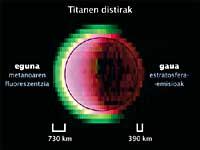 Titan Ilbera, July 2, 2004. Image made by the spectrometer of visible and infrared light maps. The circle represents the surface of the satellite. The brightness of methane looks green and that of carbon oxide in red. In the yellow zone there are two compounds. (Photo: NASA/JLP/University of Arizona). The surface of the titans is largely unknown, as dense clouds of the atmosphere prevent direct view of the surface. However, thanks to the observations made it has been possible to verify that there has been wind in the atmosphere, especially through the Hubble space telescope. The abundance of organic compounds on Titan and the possibility of a liquid medium leads us to pose another deeper question: even if it is a very cold medium, can life develop on Titan? It would be a great surprise to find traces of Titan's life, which is an extreme situation. In any case, whether or not the development of life, it is a very interesting environment to compare it with the original environment of the Earth. Cassini Huygens The Cassini-Huygens mission departed from Cape Cañaberal on October 15, 1997 and, after a journey of almost seven years, reached the Saturn system on July 1, 2004. The goal of the mission is to systematically investigate the sixth planet of the solar system, better understand the planet, its satellites, its rings and the magnetosphere. The mission, like After our great Axular, is divided into two parts, on the one hand the orbiter Cassini who governs NASA and on the other the probe Huygens that manages the ESA. Cassini will release the probe on December 24 and after three weeks of travel, on January 15, 2005, it will be incorporated into Titan's compact atmosphere. On his journey back to death, Huygens will accumulate and transmit a lot of data to get to know Titan better. 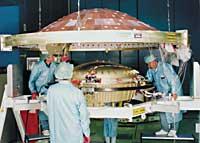 Cassini-Huygens in preparation for its release. The upper is the cone shaped shield of Huygens. ANDÉN Along with Olentzero, Huygens, of 319 kg of weight, will yield the alder of Cassini to catch the path of Titan, at a speed of 30 cm/s and at a speed of rotation of 7 minutes, to ensure the stability of the probe. However, Huygens will not lose Cassini's surveillance, as the probe's aid system will remain in the orbiter. It has a monitoring and data collection team from the probe. The atmosphere of nitrogen of the titans extends in space ten times beyond the terrestrial, which makes the first atmospheric signs are perceived about 600 kilometers from the surface of the satellite. When the probe detects the atmosphere, the alarm clock will sound and the sleeping scientific instruments will wake up. There are six in total. All five will work along the descent and all six upon landing. Huygens will use a brake system consisting of three parachutes to fall into Titan's atmosphere and will have a protective shield to protect equipment from heat until it gets to work. Due to the friction of the atmosphere, Huygens must suffer a great heat and it has been calculated that the maximum will occur in a stretch of 350-220 kilometers, since in two minutes the speed must go down from 21.600 to 1.440 km/h. Finally, the probe will land around the equator at a speed of 5 km/s. It will take about two and a half hours to get down and the “live” time is not clear if it is not destroyed when landing. This fact is also one of the curiosities of the mission. Throughout the fall you will be connected via radio with Cassini to, among other things, send the 1,100 photographs that the probe will take. Tartaro 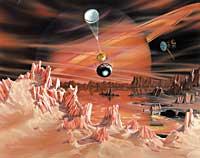 C. Altebery / NASA “They, then, in a cruel battle, faced the titans carrying stones in their strong hands. On the other side, the Titans strengthened their positions with readiness; both showed at the same time the strength of their hands and violence. The immense sea surprised; the Earth exploded greatly; the open sky complained of trembling; the vast Olympus began to ikaran from its bases because of the aggression of immortals; the heavy noise of the feet and the resentment of the last forts and chaos. How the last murderers were launched! 6€ Thus Hesiod describes the beginning of the struggle between the Titans and Zeus. If a bronze anvil thrown from Earth fell nine nights and days, the tenth day would arrive at Tartaro 7 ”, punished by the Titans, will have to make a similar descent. Don't find your Tartaro!
6th Teogonia, Hesiod, 674-685. 7. Teogonia, Hesiod, 724-725.Main physical characteristics of Titan Discoverer: Christian Huygens, 1655 Center main axis of orbit: 1.222.000 km Average orbit speed: 5.6 km/s Orbital period: 15 days, 22 hours and 41 minutes Inclination: 0.33° Average diameter: 5.150 km Surface: 83 x 10 km 2 Mass: 1,345 x 10 kg Average density Ecuador: 1.88 cm 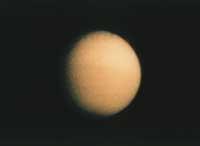 Photo NASA From the imprint of mythology The satellite of Titan Saturn is called from all the Greek gods called titans. Following what is described in the Theogony of the Greek writer Hesiodo, the Titans are the gods of the former. In total there are 12 males (Ocean, Zeo, Krio, Hyperion, Japeto and Kronos) and six females (Febe, Mnemosine, Rea, Temis, Tetis and Tea). Some of the titans also name five of Saturn's nearly 30 satellites: Febe, Hyperion, Japeto, Rea and Tetis. Four other major satellites are Mima, Entzelade, Dione and Jano, also called from Greek mythology. As Hesiod says, Kaos first existed. Then appeared Gea, wide chest, and Eros 2. Gea Urano gives birth to stardom and when lying with him creates titans. 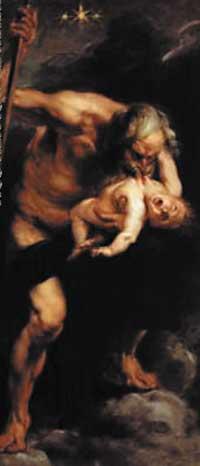 Picture of Rubens. “Then (Gea), lying with Uranus, he grew up from the Oceans of Deep Currents, Zeoz, Creme, Hyperon, Japan, Teaz, Reaz, Temis, Mnesmosín, Febez crowned in gold and Tetis pleasantly. Then was born the youngest, the wicked Kronos, the most feared of his children, who was filled with hatred towards his vigorous father 3.” Uranus did not allow the children to come out of Gea's womb, and Gea was very dissatisfied with it. Gea convinces Kronos to act against his father and, following his mother's orders, castrated Uranus. Thus, Kronos seized power, but he became a tyrant greater than his father. The Rea met his sister and, so that one of his children would not be expelled from the command, ate them at birth. He called for the collaboration of Reak Gea and Uranus. With Gea's help, instead of his younger son, he gave him a stone wrapped in a handkerchief to eat Kronos. So the newborn Zeus came out. For the most part, Zeus waged a war against the Titans, called Titanomaquia. The Titans, led by Kronos, fought against the Olympians, the Hecantocrines and the cyclops led by Zeus. It was a terrible and cruel war. Zeus won the throne of Olympus. Meanwhile, the Titans were exiled to Tartaro. “There the titans are hidden, as a consequence of Zeus’ decision, which accumulates the clouds, in a humid place, at the limits of the immense soil. They cannot get out of there because Poseidon put a bronze door and a wall around them on both sides. There live Giges, Koto and the brave Briareo 4, the faithful guardians of Zeus, bearer of thirst 5 .” Of course, the gods have special and curious powers. Uranus was not going to be less! The pieces that formed when Kronos castrated were able to fertilize, which caused the fertilization of Gea and the birth of the goddess among other giants. These groups include Mima and Entzelade. Dione is an oceanist, one of the 3000 daughters of Ocean and Tetis. Oceanoids are the personification of sources, lakes, streams, etc. Likewise, the 3,000 children of Ocean and Tetis are rivers like Nile and Eridano. Jano, however, is a Roman god and is the spirit of the porticos and porticos. It was represented with two faces. For many experts, Jano is the god of all origins and becoming one of the gates is just a derivation. At the beginning of the day, month and year they were used to worship Jano. For example, in several languages the name of January comes from the Latin Janus: january, januar, janvier, januua, janeiro…
- Hesiodo, Teogonia, Trabajos y días, Escudo, Certamen, Editorial Madrid 2003.
- Gea is also called Gaia.
- Theogony, Hesiod, 133-138.
- These are the Hecantoquiras or the looms.
- Theogony, Hesiod, 730-736.
Some details of the Cassini-Huygens mission - The result of the collaboration of three space agencies: NASA, ESA and the Italian Space Agency.
- The spacecraft is built between 17 nations.
- The Cassini orbiter is built and managed by NASA's JPL.
- The Huygens probe has been built by ESA.
- Italian Space Agency launches a successful Cassini communication antenna
- The data collected will be analyzed by 250 scientists around the world.
- He has traveled for seven years and has had to perform 4 maneuvers supported by gravity.
- The mission lasts four years and will orbit Saturn about 70 times.
- Cassini will ship several gigabytes of data daily.
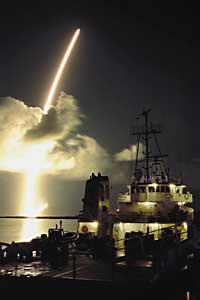 ANDÉN
Huygens Probe Scientific Tools 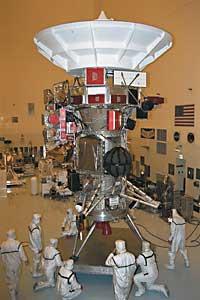 ANDÉN - Aerosol and pyrolyser collector. It will analyze the chemical composition of aerosols.
- Lowered image receiver/spectrum radiometer. It will take images and measure spectra of materials.
- Doppler wind experiment. Use radio signals to deduce the characteristics of the atmosphere.
- Gas chromatograph and mass spectrometer. Identify the components of the atmosphere.
- Atmospheric structure analysis tool. It has sensors to measure the electrical and physical characteristics of the atmosphere and a microphone to listen to the sound of the wind.
- Scientific surface pack. Set of tools that allow delimiting the surface characteristics of the impact site.
|




















